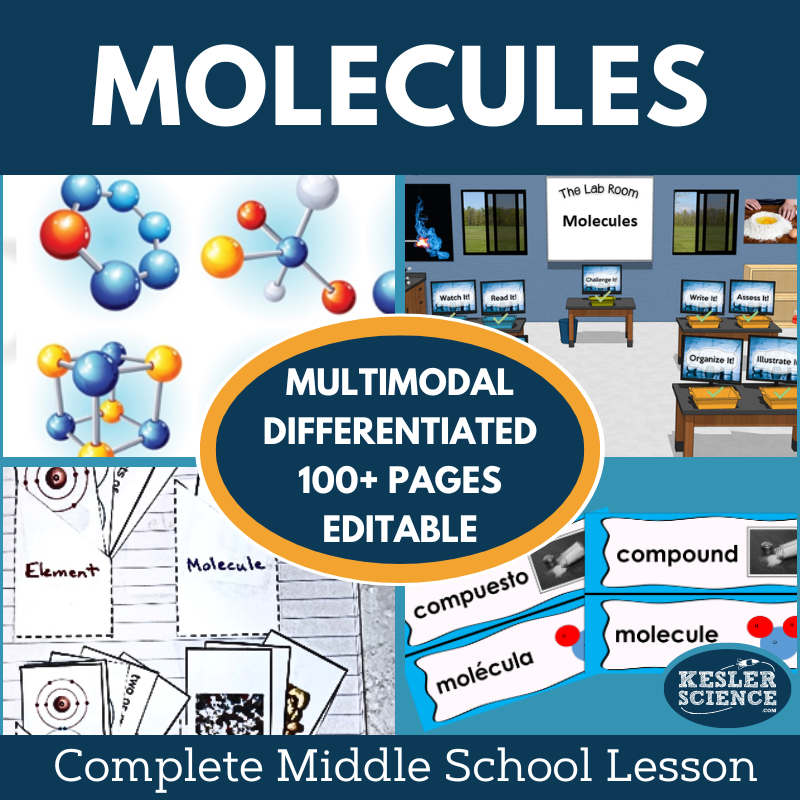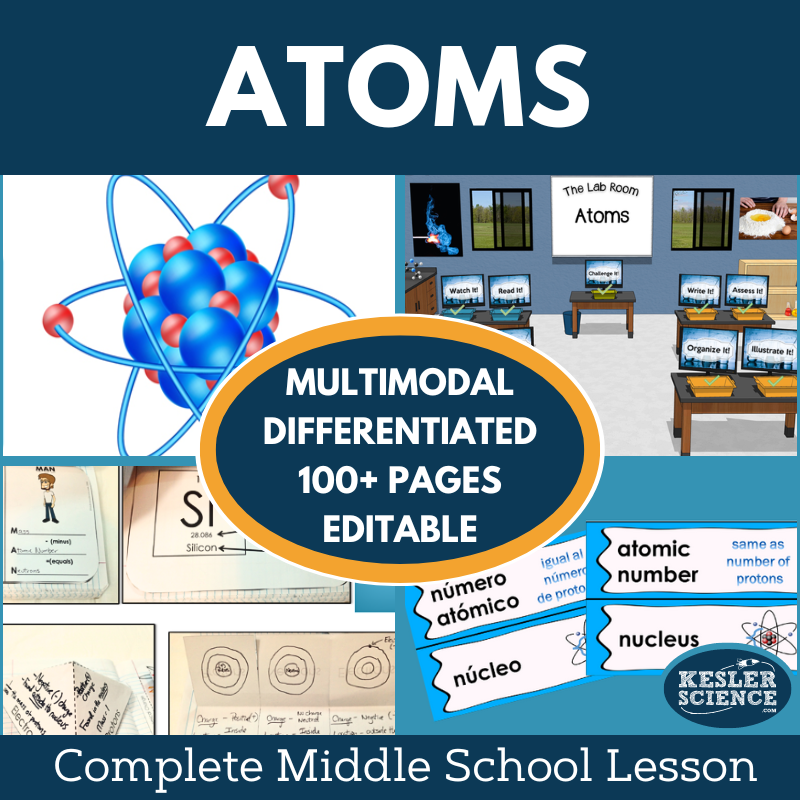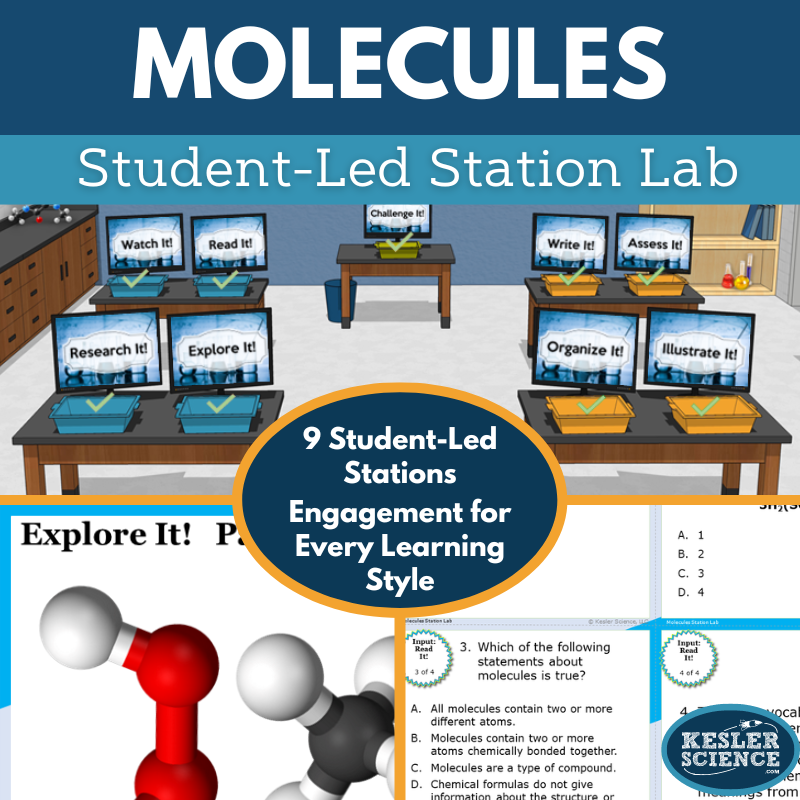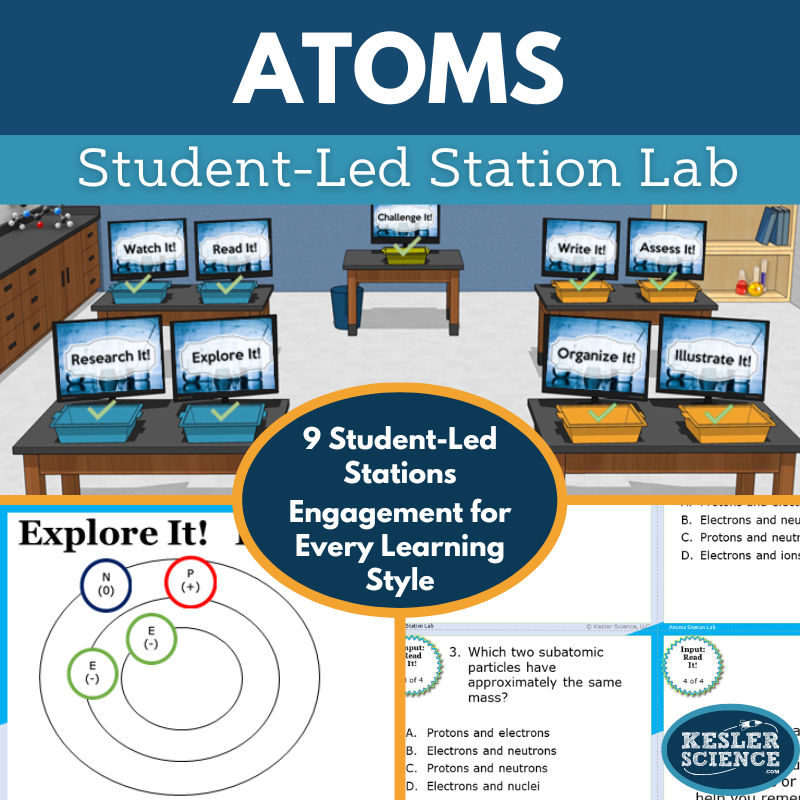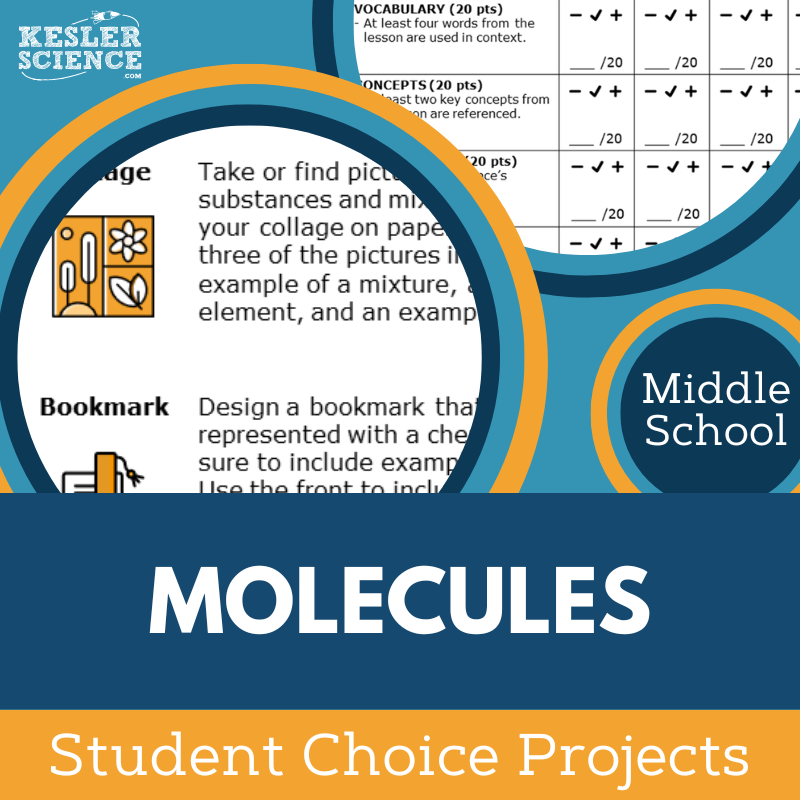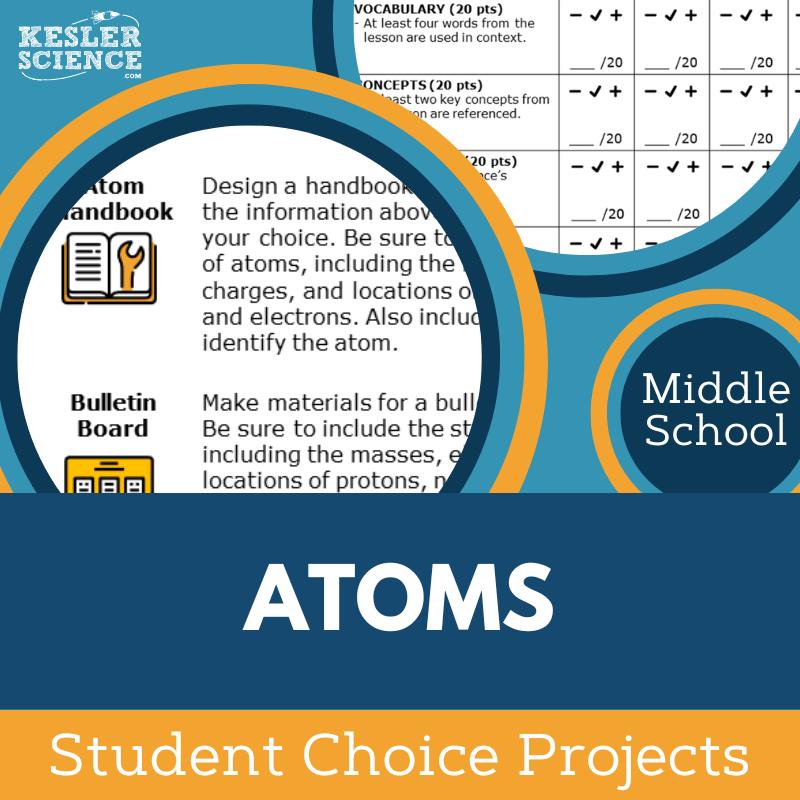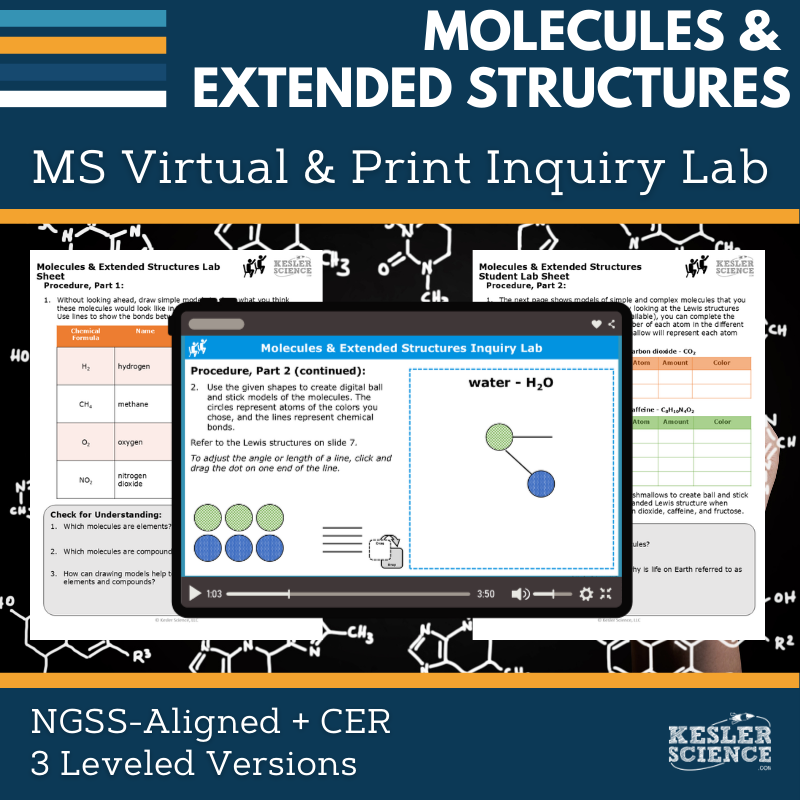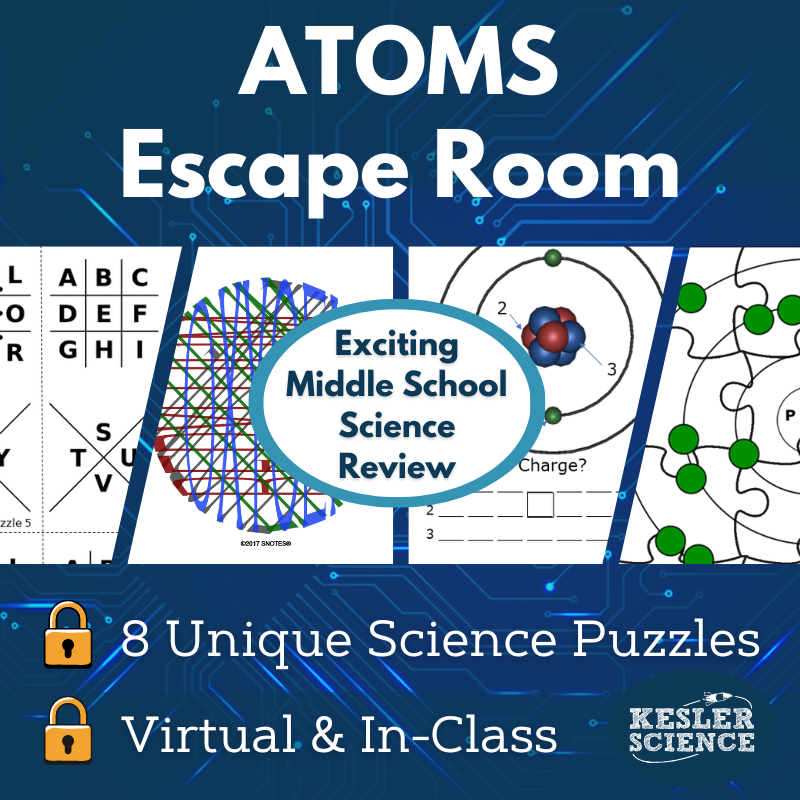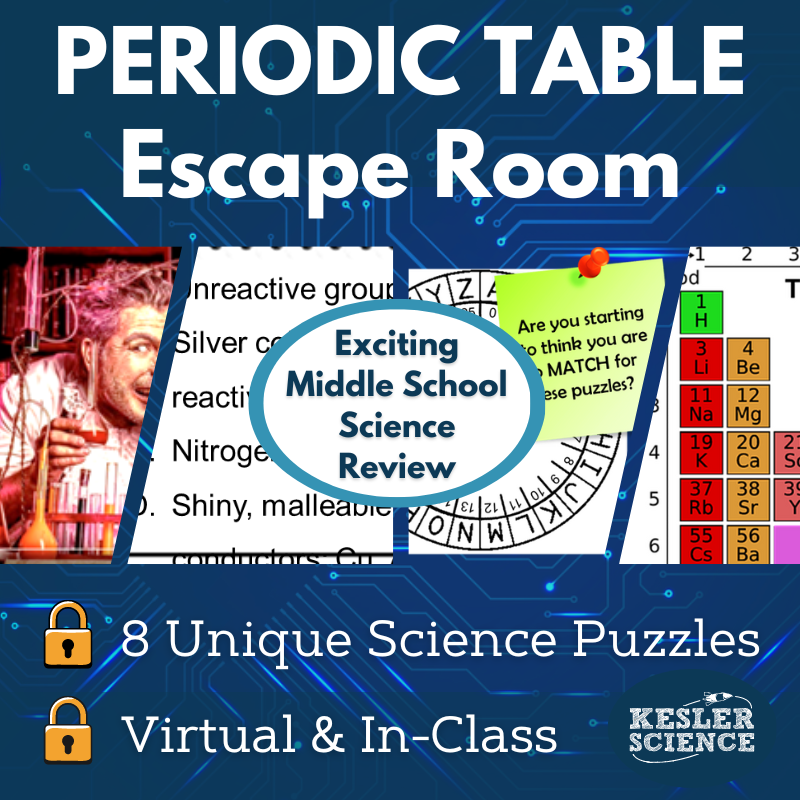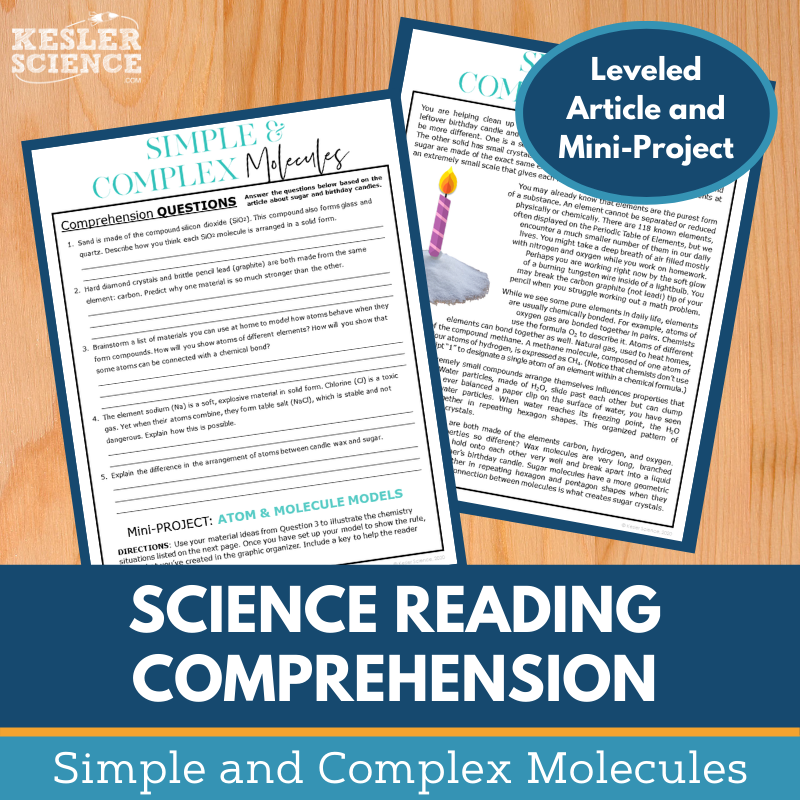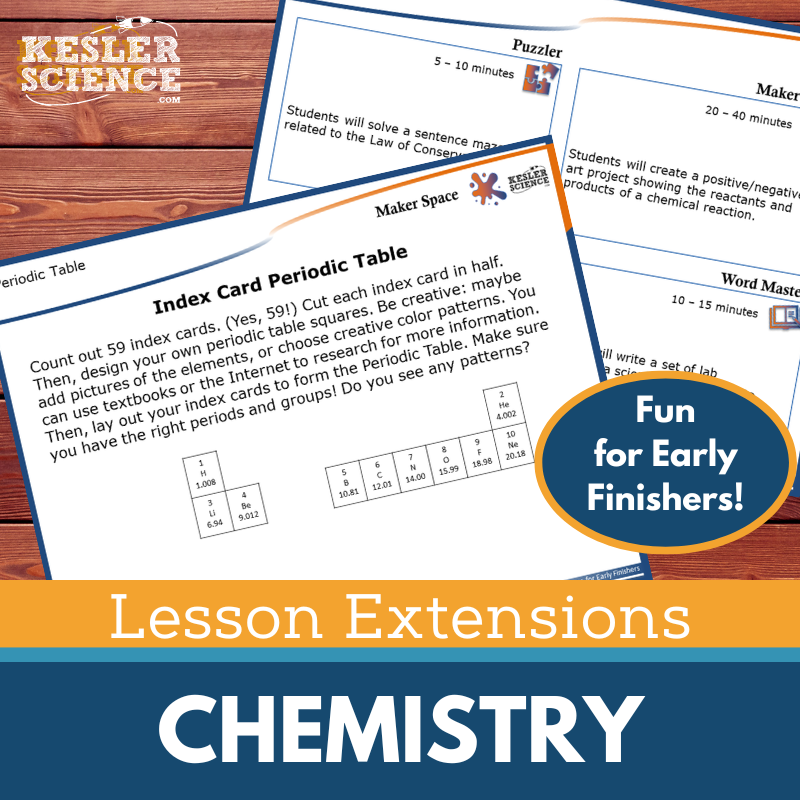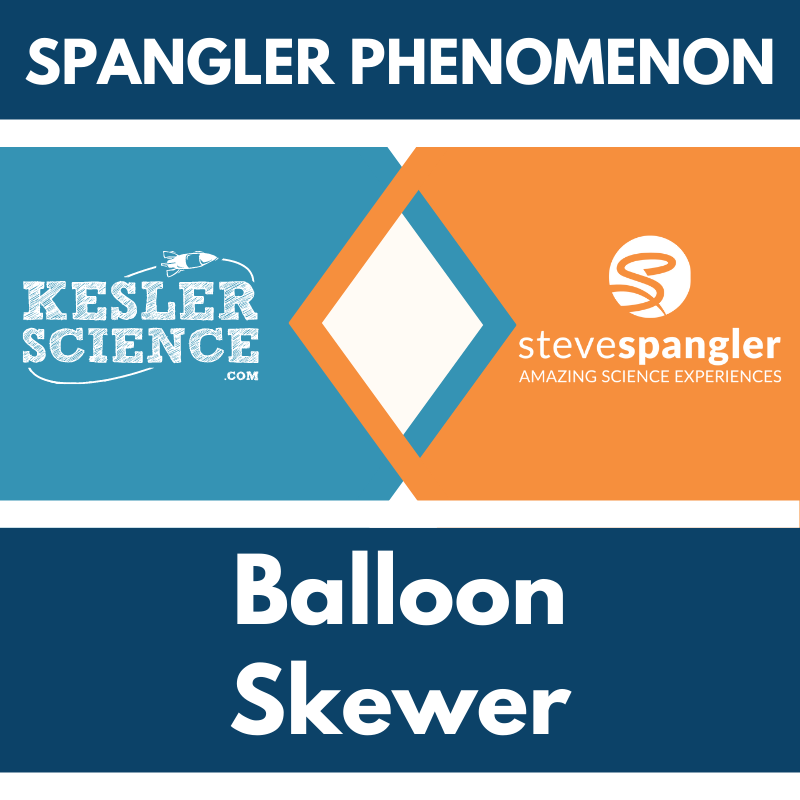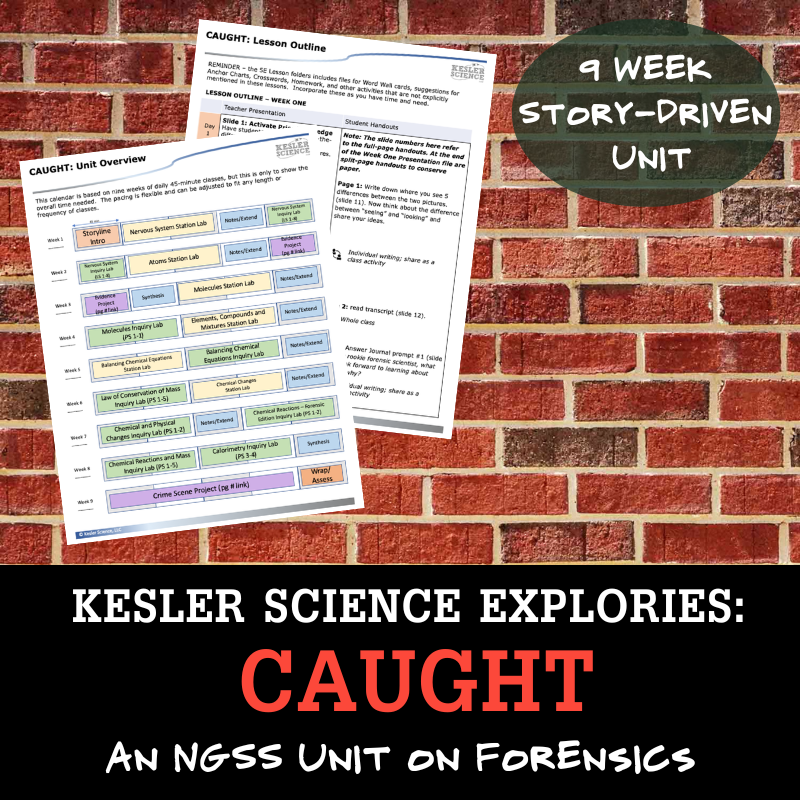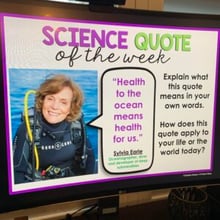Molecules & Extended Structures Activities for Middle School Science
The Molecules and Atoms 5E Lessons engage middle school students in foundational chemistry concepts through interactive, student-led activities aligned with NGSS and TEKS standards. The resources below will give students a comprehensive understanding of molecules and extended structures. All of the following materials are also included in the Kesler Science Membership.
The Kesler Science Molecules 5E Lesson is a comprehensive, student-led unit designed for middle school chemistry. It includes editable presentations, worksheets, choice projects, and assessments, all requiring minimal prep. The lesson is aligned with NGSS and TEKS standards and supports differentiated, multimodal learning with printable and digital options.
Following the 5E Model, the unit engages students with word wall cards, discussion prompts, and interactive activities. In the exploration phase, a differentiated station lab introduces molecules through hands-on demos, reading passages in English and Spanish, research tasks, and video discussions. Students demonstrate understanding through categorization, writing, drawing, and formal assessments, with a bonus challenge station for enrichment.
The explanation phase includes editable PowerPoints, interactive notebooks, and guided note-taking templates. Students elaborate on their learning with choice projects, and evaluation is supported by STAAR 2.0-aligned assessments, review questions, and worksheets. The resource is adaptable for both in-person and virtual learning environments, ensuring flexibility and engagement.
The Kesler Science Molecules 5E Lesson is a comprehensive, student-led unit designed for middle school chemistry. It includes editable presentations, worksheets, choice projects, and assessments, all requiring minimal prep. The lesson is aligned with NGSS and TEKS standards and supports differentiated, multimodal learning with printable and digital options.
Following the 5E Model, the unit engages students with word wall cards, discussion prompts, and interactive activities. In the exploration phase, a differentiated station lab introduces molecules through hands-on demos, reading passages in English and Spanish, research tasks, and video discussions. Students demonstrate understanding through categorization, writing, drawing, and formal assessments, with a bonus challenge station for enrichment.
The explanation phase includes editable PowerPoints, interactive notebooks, and guided note-taking templates. Students elaborate on their learning with choice projects, and evaluation is supported by STAAR 2.0-aligned assessments, review questions, and worksheets. The resource is adaptable for both in-person and virtual learning environments, ensuring flexibility and engagement.
The Kesler Science Atoms 5E Lesson is a comprehensive, student-led unit designed for middle school classrooms. It includes editable presentations, worksheets, assessments, and choice projects with minimal prep required. Aligned with the 2021 TEKS standards, the lesson provides differentiated materials, multimodal learning opportunities, and flexible formats, including printable and digital options. Spanish translations are available for key resources.
Following the 5E Model, the unit begins with engagement activities featuring vocabulary word wall cards and class discussions. Exploration involves a student-led station lab with nine hands-on and digital stations, allowing students to interact with concepts through reading, research, video, and activities. Explanation includes editable PowerPoints, interactive notebooks, and note-taking templates. Students elaborate through choice projects, while evaluation consists of assessment questions aligned with STAAR 2.0, review worksheets, and discussion prompts.
This lesson is fully adaptable for virtual learning, ensuring accessibility in any educational setting.
The Kesler Science Atoms 5E Lesson is a comprehensive, student-led unit designed for middle school classrooms. It includes editable presentations, worksheets, assessments, and choice projects with minimal prep required. Aligned with the 2021 TEKS standards, the lesson provides differentiated materials, multimodal learning opportunities, and flexible formats, including printable and digital options. Spanish translations are available for key resources.
Following the 5E Model, the unit begins with engagement activities featuring vocabulary word wall cards and class discussions. Exploration involves a student-led station lab with nine hands-on and digital stations, allowing students to interact with concepts through reading, research, video, and activities. Explanation includes editable PowerPoints, interactive notebooks, and note-taking templates. Students elaborate through choice projects, while evaluation consists of assessment questions aligned with STAAR 2.0, review worksheets, and discussion prompts.
This lesson is fully adaptable for virtual learning, ensuring accessibility in any educational setting.
Engage your middle school students in a dynamic, student-led station lab exploring the atomic composition of molecules and extended structures. This hands-on activity encourages independent learning through interactive stations that incorporate reading, videos, research, and hands-on tasks. With a focus on developing models to represent molecular structures, students actively build their understanding while working individually or in small groups.
Students demonstrate their learning through a variety of activities, including organizing information, sketching molecular models, writing responses, and answering assessment questions. The station lab includes differentiated reading passages in English and Spanish, ensuring accessibility for all learners. A challenge station provides extension activities such as crosswords, games, and mini-projects, offering enrichment opportunities for early finishers.
Designed for both in-person and virtual learning, this modular resource includes all necessary materials, signage, and task cards for a seamless classroom experience. Whether students manipulate images digitally or engage in hands-on tasks, this lab fosters curiosity, critical thinking, and deeper comprehension of molecular structures.
Engage your middle school students in a dynamic, student-led station lab exploring the atomic composition of molecules and extended structures. This hands-on activity encourages independent learning through interactive stations that incorporate reading, videos, research, and hands-on tasks. With a focus on developing models to represent molecular structures, students actively build their understanding while working individually or in small groups.
Students demonstrate their learning through a variety of activities, including organizing information, sketching molecular models, writing responses, and answering assessment questions. The station lab includes differentiated reading passages in English and Spanish, ensuring accessibility for all learners. A challenge station provides extension activities such as crosswords, games, and mini-projects, offering enrichment opportunities for early finishers.
Designed for both in-person and virtual learning, this modular resource includes all necessary materials, signage, and task cards for a seamless classroom experience. Whether students manipulate images digitally or engage in hands-on tasks, this lab fosters curiosity, critical thinking, and deeper comprehension of molecular structures.
Engage your middle school students with this dynamic, student-led station lab on atoms. Designed for both in-class and virtual learning, this lesson helps students explore atomic structure and understand that protons determine an element’s identity. With a hands-on, inquiry-based approach, students take charge of their learning while teachers facilitate and guide their exploration.
The lab includes eight differentiated stations that present concepts through various modalities, such as hands-on demonstrations, research, reading passages, videos, and interactive tasks. Students demonstrate their understanding by organizing information, illustrating models, writing responses, and completing assessments. A ninth challenge station provides extension activities like crosswords, games, and mini projects for early finishers or advanced learners.
All necessary materials, signage, and task cards are included, making this a low-prep yet high-engagement resource. Whether in a physical classroom or a virtual setting, students can independently or collaboratively work through the stations, fostering critical thinking and deeper comprehension of atomic structure.
Engage your middle school students with this dynamic, student-led station lab on atoms. Designed for both in-class and virtual learning, this lesson helps students explore atomic structure and understand that protons determine an element’s identity. With a hands-on, inquiry-based approach, students take charge of their learning while teachers facilitate and guide their exploration.
The lab includes eight differentiated stations that present concepts through various modalities, such as hands-on demonstrations, research, reading passages, videos, and interactive tasks. Students demonstrate their understanding by organizing information, illustrating models, writing responses, and completing assessments. A ninth challenge station provides extension activities like crosswords, games, and mini projects for early finishers or advanced learners.
All necessary materials, signage, and task cards are included, making this a low-prep yet high-engagement resource. Whether in a physical classroom or a virtual setting, students can independently or collaboratively work through the stations, fostering critical thinking and deeper comprehension of atomic structure.
The Molecules Student Choice Projects lesson allows middle school students to demonstrate their understanding in a way that suits their learning style. A project page outlines six student-led options plus a “design your own” project, with a rubric for teacher, peer, or self-assessment. These projects are flexible, allowing teachers to modify the rubric as needed. Multimodal options provide creative, personalized ways for students to showcase their knowledge.
Two versions of the project page support differentiation, with a modified version offering targeted options for students needing remediation and challenge options for advanced learners. Teachers can assign a combination of projects while using the same rubric.
The projects require standard classroom supplies such as paper, markers, and scissors, with many options available for digital completion. Some crafting materials may be useful for model-building.
The Molecules Student Choice Projects lesson allows middle school students to demonstrate their understanding in a way that suits their learning style. A project page outlines six student-led options plus a “design your own” project, with a rubric for teacher, peer, or self-assessment. These projects are flexible, allowing teachers to modify the rubric as needed. Multimodal options provide creative, personalized ways for students to showcase their knowledge.
Two versions of the project page support differentiation, with a modified version offering targeted options for students needing remediation and challenge options for advanced learners. Teachers can assign a combination of projects while using the same rubric.
The projects require standard classroom supplies such as paper, markers, and scissors, with many options available for digital completion. Some crafting materials may be useful for model-building.
The Atoms Student Choice Projects lesson allows middle school students to select a project that suits their preferred output style. A project page outlines six student-led options plus a “design your own” project, all with an editable rubric for teacher, peer, or self-assessment.
These flexible, multimodal projects give students creative ways to demonstrate their understanding. Teachers can modify the rubric to fit grading needs, and two versions of the project page support differentiation—one with modified options for students needing remediation and another with challenge opportunities for advanced learners.
The projects use standard classroom supplies like paper, markers, and scissors, with many options available for digital completion. Some crafting supplies may be useful for model-building.
The Atoms Student Choice Projects lesson allows middle school students to select a project that suits their preferred output style. A project page outlines six student-led options plus a “design your own” project, all with an editable rubric for teacher, peer, or self-assessment.
These flexible, multimodal projects give students creative ways to demonstrate their understanding. Teachers can modify the rubric to fit grading needs, and two versions of the project page support differentiation—one with modified options for students needing remediation and another with challenge opportunities for advanced learners.
The projects use standard classroom supplies like paper, markers, and scissors, with many options available for digital completion. Some crafting supplies may be useful for model-building.
The Molecules and Extended Structures Inquiry Lab aligns with NGSS MS-PS1-1, guiding students to develop models that describe the atomic composition of simple molecules and extended structures. Students create models of molecules found in common sodas, including water, carbon dioxide, fructose, and caffeine, using either a hands-on printed experiment or a digital interactive version.
This lab includes three differentiated levels to support all learners. The dependent version provides guided inquiry with structured questions, the modified version includes additional scaffolding like sentence stems and multiple-choice options, and the independent version encourages student-led exploration with minimal guidance. Both print and digital formats incorporate comprehension questions, Claim-Evidence-Reasoning (C.E.R.) prompts, and a reflection section.
For the hands-on version, students use mini marshmallows and toothpicks to construct molecular models. The digital format, compatible with Google Slides and major LMS platforms, includes interactive activities that require no physical materials, making it ideal for flexible learning environments.
Teachers benefit from editable resources, answer keys, and teacher guides that outline standards, objectives, preparation time, and instructional directions. This lab supports multimodal learning, ensuring engagement for middle school students through a mix of structured guidance and inquiry-based exploration.
The Molecules and Extended Structures Inquiry Lab aligns with NGSS MS-PS1-1, guiding students to develop models that describe the atomic composition of simple molecules and extended structures. Students create models of molecules found in common sodas, including water, carbon dioxide, fructose, and caffeine, using either a hands-on printed experiment or a digital interactive version.
This lab includes three differentiated levels to support all learners. The dependent version provides guided inquiry with structured questions, the modified version includes additional scaffolding like sentence stems and multiple-choice options, and the independent version encourages student-led exploration with minimal guidance. Both print and digital formats incorporate comprehension questions, Claim-Evidence-Reasoning (C.E.R.) prompts, and a reflection section.
For the hands-on version, students use mini marshmallows and toothpicks to construct molecular models. The digital format, compatible with Google Slides and major LMS platforms, includes interactive activities that require no physical materials, making it ideal for flexible learning environments.
Teachers benefit from editable resources, answer keys, and teacher guides that outline standards, objectives, preparation time, and instructional directions. This lab supports multimodal learning, ensuring engagement for middle school students through a mix of structured guidance and inquiry-based exploration.
The Atoms Escape Room is an interactive activity that allows students to demonstrate their understanding of atoms in a fun and engaging way. Students should be familiar with protons, neutrons, and electrons, including their location, charge, and how to identify valence electrons using a Bohr model or element symbol.
This escape room offers flexibility, allowing teachers to choose from eight independent puzzles to fit different class periods. It includes a video introduction, printable props, teacher directions, detailed answer keys, an editable PowerPoint version, and digital formats for online learning. A Google Forms answer sheet is available for classrooms using Google tools. Additional resources include prize ideas, reward templates, and themed signs for student photos.
Materials needed vary based on implementation. A basic setup requires printed materials, manila envelopes, and a small mirror or reflective surface. For a more immersive experience, teachers can incorporate locks, a lockout hasp, and a storage box. Digital options allow students to complete the escape room using PowerPoint or Google Slides, with a printable version available for home use.
The Atoms Escape Room is an interactive activity that allows students to demonstrate their understanding of atoms in a fun and engaging way. Students should be familiar with protons, neutrons, and electrons, including their location, charge, and how to identify valence electrons using a Bohr model or element symbol.
This escape room offers flexibility, allowing teachers to choose from eight independent puzzles to fit different class periods. It includes a video introduction, printable props, teacher directions, detailed answer keys, an editable PowerPoint version, and digital formats for online learning. A Google Forms answer sheet is available for classrooms using Google tools. Additional resources include prize ideas, reward templates, and themed signs for student photos.
Materials needed vary based on implementation. A basic setup requires printed materials, manila envelopes, and a small mirror or reflective surface. For a more immersive experience, teachers can incorporate locks, a lockout hasp, and a storage box. Digital options allow students to complete the escape room using PowerPoint or Google Slides, with a printable version available for home use.
The Periodic Table Escape Room is an engaging, interactive activity that allows students to demonstrate their understanding of periodic table organization, including valence electrons, periods, groups, families, and reactivity. Designed to align with TEKS and NGSS standards, this escape room reinforces atomic structure and periodic trends in a fun, hands-on way.
Teachers have full control over the eight independent puzzles, allowing customization based on class time and student needs. The escape room can be conducted using manila envelopes for a simple setup or a more immersive lock-and-box format. A digital version is available for online learning, with a PowerPoint file that can be assigned through email or a learning management system and uploaded to Google Slides. A printable version is also provided for at-home use.
This resource includes teacher directions, detailed answer keys, a digital answer sheet, video challenges, printable props, editable templates, and reward templates. With over 50 prize ideas and unique signs for students to celebrate their success, this escape room ensures an exciting and memorable learning experience.
The Periodic Table Escape Room is an engaging, interactive activity that allows students to demonstrate their understanding of periodic table organization, including valence electrons, periods, groups, families, and reactivity. Designed to align with TEKS and NGSS standards, this escape room reinforces atomic structure and periodic trends in a fun, hands-on way.
Teachers have full control over the eight independent puzzles, allowing customization based on class time and student needs. The escape room can be conducted using manila envelopes for a simple setup or a more immersive lock-and-box format. A digital version is available for online learning, with a PowerPoint file that can be assigned through email or a learning management system and uploaded to Google Slides. A printable version is also provided for at-home use.
This resource includes teacher directions, detailed answer keys, a digital answer sheet, video challenges, printable props, editable templates, and reward templates. With over 50 prize ideas and unique signs for students to celebrate their success, this escape room ensures an exciting and memorable learning experience.
This Simple and Complex Molecules Science Reading Comprehension Lesson helps students explore simple and complex molecules through a nonfiction article. Designed for middle school, the leveled passage supports science literacy and reading comprehension.
The resource includes comprehension questions, a hands-on mini-project for modeling atoms and molecules, and a Cornell notes template. The passage is available in two Lexile levels (1100-1300) and features engaging visuals that print easily in grayscale.
Ideal for sub plans, ISS, extra credit, or whole-class instruction, this resource encourages critical thinking, classroom discussions, and textual analysis. It is compatible with digital platforms like Google Classroom, MS Teams, Schoology, and Canvas, allowing students to complete activities in both in-person and virtual learning environments.
This Simple and Complex Molecules Science Reading Comprehension Lesson helps students explore simple and complex molecules through a nonfiction article. Designed for middle school, the leveled passage supports science literacy and reading comprehension.
The resource includes comprehension questions, a hands-on mini-project for modeling atoms and molecules, and a Cornell notes template. The passage is available in two Lexile levels (1100-1300) and features engaging visuals that print easily in grayscale.
Ideal for sub plans, ISS, extra credit, or whole-class instruction, this resource encourages critical thinking, classroom discussions, and textual analysis. It is compatible with digital platforms like Google Classroom, MS Teams, Schoology, and Canvas, allowing students to complete activities in both in-person and virtual learning environments.
The Structure of Molecules Science Writing Prompt Activity engages middle school students in a creative exercise using a song to reinforce their understanding of physical science. Aligned with NGSS MS-PS1-1, this low-prep, student-centered activity supports science reasoning and exploration while accommodating both in-person and virtual learning.
This resource includes teacher directions with an answer guide, project ideas, and rubrics, as well as projection and print handouts in full-sized and half-sheet formats. A digital PowerPoint version, compatible with Google Slides, allows for remote or in-class assignments. Ideal for cross-curricular activities, pre-test assessments, student choice projects, early finisher tasks, extra credit, make-up work, and differentiation, this engaging writing prompt fosters creativity and science literacy in the classroom.
The Structure of Molecules Science Writing Prompt Activity engages middle school students in a creative exercise using a song to reinforce their understanding of physical science. Aligned with NGSS MS-PS1-1, this low-prep, student-centered activity supports science reasoning and exploration while accommodating both in-person and virtual learning.
This resource includes teacher directions with an answer guide, project ideas, and rubrics, as well as projection and print handouts in full-sized and half-sheet formats. A digital PowerPoint version, compatible with Google Slides, allows for remote or in-class assignments. Ideal for cross-curricular activities, pre-test assessments, student choice projects, early finisher tasks, extra credit, make-up work, and differentiation, this engaging writing prompt fosters creativity and science literacy in the classroom.
Lesson Extensions provide engaging, student-choice activities that challenge early finishers while reinforcing critical thinking and creativity. These activities help wrap up lessons, fill downtime, and keep students focused with rigorous yet enjoyable learning opportunities. Designed to scaffold learning, they align with NGSS and TEKS chemistry standards, encouraging students to explore concepts more deeply.
Each extension includes four interactive components: Puzzler for problem-solving, Maker Space for hands-on STEAM activities, Tech Connection for digital demonstrations, and Word Master for creative writing. Teacher directions, answer keys, and both print and projection versions make implementation easy.
Covering topics such as atomic structures, chemical reactions, the periodic table, and more, these extensions enhance independent learning with puzzles, hands-on activities, and creative challenges that enrich the chemistry classroom.
Lesson Extensions provide engaging, student-choice activities that challenge early finishers while reinforcing critical thinking and creativity. These activities help wrap up lessons, fill downtime, and keep students focused with rigorous yet enjoyable learning opportunities. Designed to scaffold learning, they align with NGSS and TEKS chemistry standards, encouraging students to explore concepts more deeply.
Each extension includes four interactive components: Puzzler for problem-solving, Maker Space for hands-on STEAM activities, Tech Connection for digital demonstrations, and Word Master for creative writing. Teacher directions, answer keys, and both print and projection versions make implementation easy.
Covering topics such as atomic structures, chemical reactions, the periodic table, and more, these extensions enhance independent learning with puzzles, hands-on activities, and creative challenges that enrich the chemistry classroom.
This Amazing Anchors Phenomenon Lesson engages students in atomic composition through a real-world connection to disappearing salt. It includes an introductory reading with comprehension and extension questions to prepare students for further learning, followed by an explanatory reading that breaks down atomic composition in an accessible way, reinforcing understanding with additional questions.
Aligned with NGSS standard MS PS1-1, this no-prep resource includes teacher directions with answer keys, projection slides, and both print and digital formats for use in Google Classroom or other LMS platforms. Full- and half-sheet handouts are provided for interactive notebooks. A differentiated version offers sentence starters to support students in answering comprehension questions. Designed to bookend a lesson, these engaging readings enhance any in-person or virtual classroom.
This Amazing Anchors Phenomenon Lesson engages students in atomic composition through a real-world connection to disappearing salt. It includes an introductory reading with comprehension and extension questions to prepare students for further learning, followed by an explanatory reading that breaks down atomic composition in an accessible way, reinforcing understanding with additional questions.
Aligned with NGSS standard MS PS1-1, this no-prep resource includes teacher directions with answer keys, projection slides, and both print and digital formats for use in Google Classroom or other LMS platforms. Full- and half-sheet handouts are provided for interactive notebooks. A differentiated version offers sentence starters to support students in answering comprehension questions. Designed to bookend a lesson, these engaging readings enhance any in-person or virtual classroom.
This Spangler Phenomenon lesson on molecules and extended structures features an exclusive Steve Spangler video designed to captivate students and challenge their analytical thinking. The interactive investigation centers around the question: What seems impossible about poking a skewer through a balloon?
Aligned with the 5E framework and NGSS standard MS-PS1-1, this lesson explores atomic composition through engaging, hands-on activities. In Part 1: Think Like a Scientist, students watch the Balloon Skewer video and create slime, encouraging them to analyze real-world phenomena. In Part 2: Study Like a Scientist, they gather information from an article on molecules and extended structures, with options to expand learning through additional labs. In Part 3: Work Like a Scientist, students revisit their conclusions after watching Steve Spangler’s explanation video, then demonstrate their understanding through writing, drawing, or building activities.
This lesson includes detailed teacher instructions, classroom handouts, two Steve Spangler videos, interactive presentation slides, PowerPoints optimized for Google Slides, and Vimeo links to ensure an ad-free viewing experience.
This Spangler Phenomenon lesson on molecules and extended structures features an exclusive Steve Spangler video designed to captivate students and challenge their analytical thinking. The interactive investigation centers around the question: What seems impossible about poking a skewer through a balloon?
Aligned with the 5E framework and NGSS standard MS-PS1-1, this lesson explores atomic composition through engaging, hands-on activities. In Part 1: Think Like a Scientist, students watch the Balloon Skewer video and create slime, encouraging them to analyze real-world phenomena. In Part 2: Study Like a Scientist, they gather information from an article on molecules and extended structures, with options to expand learning through additional labs. In Part 3: Work Like a Scientist, students revisit their conclusions after watching Steve Spangler’s explanation video, then demonstrate their understanding through writing, drawing, or building activities.
This lesson includes detailed teacher instructions, classroom handouts, two Steve Spangler videos, interactive presentation slides, PowerPoints optimized for Google Slides, and Vimeo links to ensure an ad-free viewing experience.
"Explories: CAUGHT” is an NGSS unit that immerses students in a Forensics Academy, where they learn chemistry principles and evidence-gathering skills to solve a non-violent crime. Through this interactive experience, students progress through training levels, earning badges as they develop investigative techniques. They begin with an introduction to the nervous system and sensory processes before moving on to crime scene evidence collection and analysis. Chemistry lessons equip students with the skills to examine substances like lipstick and blood, culminating in the creation of a Rookie Handbook that aids them in solving their first case with a field partner.
This unit includes day-by-day teacher instructions, two unit projects, six station labs, eight inquiry labs, six 5E lessons, student activity pages, project-based and traditional assessments, rubrics for feedback and standards-based grading, journaling and synthesis activities, and two training videos on how to use the files. It aligns with NGSS standards related to atomic structure, chemical reactions, conservation of mass, energy transfer, and sensory processing.
"Explories: CAUGHT” is an NGSS unit that immerses students in a Forensics Academy, where they learn chemistry principles and evidence-gathering skills to solve a non-violent crime. Through this interactive experience, students progress through training levels, earning badges as they develop investigative techniques. They begin with an introduction to the nervous system and sensory processes before moving on to crime scene evidence collection and analysis. Chemistry lessons equip students with the skills to examine substances like lipstick and blood, culminating in the creation of a Rookie Handbook that aids them in solving their first case with a field partner.
This unit includes day-by-day teacher instructions, two unit projects, six station labs, eight inquiry labs, six 5E lessons, student activity pages, project-based and traditional assessments, rubrics for feedback and standards-based grading, journaling and synthesis activities, and two training videos on how to use the files. It aligns with NGSS standards related to atomic structure, chemical reactions, conservation of mass, energy transfer, and sensory processing.
Year-Round Resources
These year-round activities will increase your students' understanding of many middle school science topics. All of these activities are also included in the Kesler Science Membership.
Visual Data & Graphing
You're not alone if your students struggle with understanding graphs, charts, and tables. It's a skill that takes an enormous amount of practice. This resource will help students build a strong foundation in analyzing data and creating their own data visualizations.
Bell Ringers and Warm-Ups
These middle school science bell ringers are an excellent way to engage your students as soon as they walk into your classroom. This comprehensive FULL YEAR resource includes everything you need to start off each science class with an interesting warm-up activity.
Review Board Games
Each game board has been carefully designed to keep students engaged. There are 10 different action spaces on each board and dozens of question cards. All of the actions are related to science concepts and keep the students motivated throughout the game.
Each game is ready to play. Simply print out the board and the cards and let the students enjoy reviewing nine different units.
Essential Questions and Standards
Below are the essential questions and standards associated with the lessons and activities included in the molecules and extended structures unit. This topic is only one of more than 100 middle school science topics included in the Kesler Science Membership.
-
What is a pure substance?
-
What can be represented with chemical symbols?
-
What is the basic structure of atoms?
-
How is an atom’s mass calculated?
-
Which subatomic particles are electrically charged?
-
Where are the three main subatomic particles located?
-
How do protons determine an atom’s identity?
-
NGSS - MS-PS1-1 Molecules & Extended Structures
Kesler Science Membership
Imagine never having to search for another middle school science lesson again. The membership gives you access to ALL of the Kesler Science products in one place (Yes, including everything above).
Say goodbye to long hours of lesson prep.

